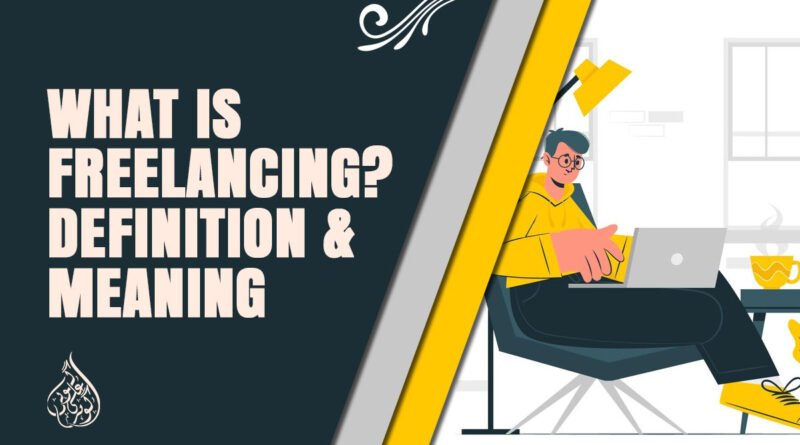What is freelancing? How to Start Freelancing in 2024.
Have you ever heard about freelancing but feel unsure about what it really means? Many people are curious to know what is freelancing and how it works.
Freelancing offers a unique way to work independently. It gives you the freedom to choose your projects and clients.
With the rise of the digital world, freelancing has become more popular. However, starting a freelance career can seem overwhelming.
What skills do you need? How do you find clients?
In this blog post, we’ll break down what freelancing is and how it can help you start making money online.
By the end, you’ll have a clear understanding of freelancing and how to begin.
What is Freelancing?
Freelancing is a form of self-employment. Unlike traditional jobs, freelancers don’t work for a single employer.
They have the freedom to work for multiple clients. This allows them to live anywhere with a reliable internet connection.
Freelancers control when and where they work. They can choose projects that interest them.
The COVID-19 pandemic has greatly influenced freelancing. Many people lost their full-time jobs due to the pandemic.
In response, individuals turned to freelancing to make ends meet. The gig economy saw significant growth during this period.
The rise of remote work and online platforms has made freelancing more accessible.
The pandemic accelerated this trend, leading to a surge in self-employment.
What Does Freelancers Do?

A freelancer is someone who works for themselves. They offer their services directly to clients.
Unlike traditional employees, freelancers are not bound to a single company. They have the freedom to choose who they work for and when.
Freelancers can provide a wide range of services like graphic design, video editing, content writing, social media management, web development, and more.
It’s recommended for freelancers to focus on one specific niche and specialize in relevant skills. The more they are focused, the more they will learn.
One key aspect of freelancing is direct client interaction. Freelancers communicate with clients to understand their needs and deliver the work.
They often use different freelance marketplaces like Fiverr, Upwork, and Freelancer, etc. to find work. These platforms connect freelancers with clients looking for their skills.
Freelancing is all about self-employment. It allows individuals to control their work schedule and project choices.
The beauty of freelancing lies in its flexibility. Freelancers can work from anywhere with an internet connection.
Read this: 10 Practical Ways of Online Earning in Pakistan
What is the Demand of Freelancing?
The demand for freelancers has been growing rapidly. Many people have turned to freelancing due to job losses and economic shifts.
For example, in the USA, unemployment rates were high, reaching around 6.011 million in November 2022.
This situation pushed many to learn new online skills like graphic design, web development, content writing, etc., and start freelancing.
Freelancers now contribute significantly to the economy. According to an Upwork report, about 59 million Americans are freelancing.
These freelancers generate around $1.2 trillion in annual earnings. This growth is part of a larger trend in the gig economy.
The pandemic has accelerated the rise of freelancing. It has created more opportunities for self-employment and remote work.
Freelancers from South Asia, including India and Pakistan, are also benefiting. They are joining the global freelance market and helping drive economic growth.
Pakistan was declared the 4th fast-growing country in the freelancing industry with a significant growth of 48% in 2021.
The freelance economy is expanding globally. More people are choosing freelancing as a viable career option.
This trend is not just a temporary shift. Freelancing is becoming a permanent and important part of the job market.
What is the Future of Freelancing?
Freelancing is shaping the future of work. More businesses are turning to freelancers for their needs.
Hiring freelancers is cost-effective for companies. It allows them to complete short-term projects without hiring permanent staff.
This flexibility benefits both businesses and freelancers. Companies can find specialized skills when needed.
In South Asia, freelancing is gaining popularity. Countries like India, Pakistan, and the Philippines are seeing a rise in freelance work.
Freelancers enjoy significant benefits. They can choose when, where, and on what projects they work.
This flexibility leads to higher job satisfaction. Many freelancers appreciate the freedom to manage their own schedules.
The future looks bright for freelancing. The demand for freelance work continues to grow.
Freelancing platforms like Upwork and Fiverr are seeing more activity. These sites are experiencing increased numbers of projects and freelancers.
With the ongoing rise in freelancing, it’s clear this trend is here to stay. The gig economy is creating new opportunities worldwide.
Read more: Top 12 Real Online Jobs For Students
How to Start Freelancing?

Getting started as a freelancer is not that difficult if you are truly committed to doing it. It is recommended to start it part-time and when you see it going then you can adopt it as a full-time job.
Here are some necessary steps you need to follow to start freelancing.
1. Learn a Skill
The first and foremost requirement for starting freelancing is to have a skill. It can be anything like graphic design, video editing, content writing, or web development.
If you are just starting, go and learn a skill first. It is always recommended to choose a skill of your interest regardless of its scope and demand.
When you love doing something, you will not get bored and can take it longer. Ultimately, you will succeed in that.
There are various free and paid platforms to learn skills from, but I would highly recommend going with freebies. YouTube is full of different free courses, so always look for that.
You can also learn from Udemy, Coursera, and others. Go and grab that opportunity now.
2. Build a Portfolio
When you have mastered a skill, it’s time to build your portfolio. A portfolio is a collection of work that you have done for others or yourself.
Building a portfolio is crucial. Showcasing your best work can attract potential clients so pick the best work and put it in your portfolio.
Remember, your portfolio will attract clients, so try to make it strong and professional. Don’t include things in your portfolio that you have copied from others. Always Keep it genuine and creative.
There are a few websites like Flickr, Dribble, Behance, etc. where you can showcase your portfolio for free.
But if you can afford it then I would strongly recommend that you make your portfolio website. It will make your reputation more high.
3. Build Your Network
Building your network as a freelancer is very important. When you connect with other professionals in your field, you will gain more experience and your skill set will improve.
When your network is strong, you will get more working opportunities. You can build your network by joining different groups and communities online.
Appreciate the quality work of others and get feedback from them on your work.
4. Become a Brand
A freelancer should think and act like a brand if they want to dominate in this field. You will have to work hard on every project and focus on delivering quality work.
Initially, you might need to charge lower rates. This helps you build experience and gain clients.
When you over-deliver and make the client happy, you earn a loyal customer. A few loyal customers are enough for your lifetime. They will never let you be jobless.
When you provide quality, they will always come back to you and even refer more clients as well.
What Challenges Are Faced by Freelancers?
Freelancing is not without its challenges. It’s important to be aware of these before you start.
1. Managing Expenses
One major challenge is handling expenses. You will need to pay for your own tools and software.
For example, a graphic designer needs Adobe Creative Suite. A photographer requires cameras and editing software.
2. Building a Portfolio
Building a strong portfolio takes time. You might need to start by charging lower rates.
This helps you gain experience and attract clients. A solid portfolio can lead to better-paying opportunities.
3. Handling Taxes
Freelancers must manage their own taxes. This often means higher tax rates compared to regular employees.
It’s crucial to set aside money for taxes throughout the year. Proper planning can help avoid surprises at tax time.
4. Time Management
Time management is a key skill for freelancers. Without a fixed schedule, staying organized can be challenging.
Effective time management helps ensure you meet deadlines. It also allows you to balance multiple projects.
5. Client Relations
Maintaining good client relationships is essential. Excellent customer service can lead to repeat business.
Responding promptly and delivering high-quality work builds trust. Happy clients are more likely to refer you to others.
6. Work-Life Balance
Freelancers must manage their work-life balance. Working from home can blur the lines between work and personal life.
Setting boundaries and creating a dedicated workspace can help. It’s important to find a balance that works for you.
Conclusion
Freelancing is a powerful way to take control of your career. It offers the flexibility to work on your terms and choose projects that interest you.
From understanding what freelancing is to recognizing the rise in demand, it’s clear that freelancing is more than just a trend. It’s a viable career path that continues to grow globally.
While the future of freelancing looks bright, it’s important to understand the challenges. Managing expenses, handling taxes, and maintaining a work-life balance are all crucial considerations.
Despite these challenges, many find freelancing to be rewarding and fulfilling. It provides an opportunity to leverage your skills and create a unique career path.
Whether you’re looking to start freelancing part-time or dive in full-time, the journey can be exciting. By preparing and understanding what freelancing entails, you can set yourself up for success.
Embrace the freedom and opportunities freelancing offers. With determination and the right approach, you can build a thriving freelance career and enjoy the benefits of working independently.
FAQs
1. What is freelancing?
Freelancing is a form of self-employment where individuals offer their services to clients on a project basis, rather than working for a single employer.
2. How do I start freelancing?
To start freelancing, identify your skills, build a portfolio, set your rates, and join freelance marketplaces like Upwork, Fiverr, or Freelancer to find clients.
3. What skills are in demand for freelancers?
In-demand skills for freelancers include graphic design, web development, writing, marketing, virtual assistance, and project management.
4. How much can I earn as a freelancer?
Freelancer earnings vary widely based on skills, experience, and the type of projects. Rates can range from $10 to $75 per hour or more.
5. Do I need to pay taxes as a freelancer?
Yes, freelancers must pay taxes on their earnings. It’s important to set aside a portion of your income for taxes and understand the tax requirements in your country.
6. How can I manage my time effectively as a freelancer?
Effective time management involves setting a schedule, using productivity tools, prioritizing tasks, and setting clear deadlines to ensure you meet client expectations.
7. What are the advantages of freelancing?
Freelancing offers flexibility, the ability to choose your projects, work from anywhere, and potentially earn a higher income compared to traditional jobs.
8. What are the common challenges of freelancing?
Common challenges include managing expenses, handling taxes, maintaining a work-life balance, finding clients, and dealing with inconsistent income.
9. Can I freelance while working a full-time job?
Yes, many people start freelancing part-time while maintaining their full-time job to test the waters and gradually build their freelance business.
10. How can I attract clients as a freelancer?
Attract clients by building a strong portfolio, providing excellent customer service, networking, marketing your services, and maintaining a professional online presence.




